
The war droned on, as did the sounds of planes flying across the skies of the battlefront. Within the relative safety of their studios and animation desks, many a cartoonist stayed well behind the lines, trying to prove with deft slashes at countless sheets of paper that the pencil could be mightier than the sword, each winning the war single-handed, both in the air and on the ground – at least in the imagery created from his drawing board. While no foreign dictator was as yet willing to negotiate surrender terms with an armed mouse, duck, or goose, these artists’ creations continued to score major victories in a never-ending battle – to maintain public morale in a war-torn world, and remind movie-goers that it was still possible not only to have a light-hearted laugh or two, but even to swell with pride over the efforts the country was doing to keep the oppressors at bay. The industry was, indeed, flying high.
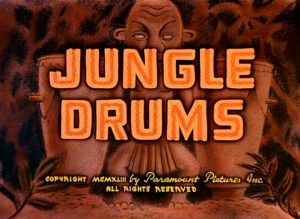 Jungle Drums (Paramount/Famous, Superman, 3/26/43 – Dan Gordon, dir.) – Ah, those nasty Nazis are everywhere. This time, they man a secret outpost among a tribe of African natives, with anti-aircraft guns concealed atop the giant heads of carved idols of native war gods. A German commander, in charge of a radio base and gunnery concealed within the idols, controls the local tribes by donning a robe and playing witch doctor. We can only wonder how he originally infiltrated the native ranks, let alone got all his equipment installed within the secret base. We can further wonder how such a remote location in the jungle just happens to lie directly in the path of an air lane used by the Allies. (Wouldn’t you suppose our intelligence staffs would keep their air routes varied or serpentine to avoid such a happenstance?) Nevertheless, the idol’s towers are positioned at dead center as an Allied plane flies overhead, and the enemy gunners quickly score a direct hit on the plane’s tail, sending it down for a crash into the jungle. Indestructible Lois Lane, now apparently acting as a war correspondent, rises from the wreckage unhurt and unscratched. But the pilot is about done for, and hands Lane “important papers” with instructions to destroy them. We learn as the story progresses that they contain information about the location and departure of an American convoy – which of course the Nazis already knew were contained within the plane. Loose lips sink ships. But why write such information down? Couldn’t the pilot have just committed it to memory to avoid such a happenstance? Lois has no sooner tucked the papers into her blouse, than her wrists are seized by a pair of warriors from the tribe, sent out to search the wreck. Natives, like all villains’ henchmen, are dum-dums, and they fail to notice the papers on Lois, and return with her as prisoner, but empty-handed as to the true goal of their mission. To ensure that the information is not discovered, Lois pretends to stumble on the walk back, but quickly stashes the papers under a rock before anyone can spot her trickery.
Jungle Drums (Paramount/Famous, Superman, 3/26/43 – Dan Gordon, dir.) – Ah, those nasty Nazis are everywhere. This time, they man a secret outpost among a tribe of African natives, with anti-aircraft guns concealed atop the giant heads of carved idols of native war gods. A German commander, in charge of a radio base and gunnery concealed within the idols, controls the local tribes by donning a robe and playing witch doctor. We can only wonder how he originally infiltrated the native ranks, let alone got all his equipment installed within the secret base. We can further wonder how such a remote location in the jungle just happens to lie directly in the path of an air lane used by the Allies. (Wouldn’t you suppose our intelligence staffs would keep their air routes varied or serpentine to avoid such a happenstance?) Nevertheless, the idol’s towers are positioned at dead center as an Allied plane flies overhead, and the enemy gunners quickly score a direct hit on the plane’s tail, sending it down for a crash into the jungle. Indestructible Lois Lane, now apparently acting as a war correspondent, rises from the wreckage unhurt and unscratched. But the pilot is about done for, and hands Lane “important papers” with instructions to destroy them. We learn as the story progresses that they contain information about the location and departure of an American convoy – which of course the Nazis already knew were contained within the plane. Loose lips sink ships. But why write such information down? Couldn’t the pilot have just committed it to memory to avoid such a happenstance? Lois has no sooner tucked the papers into her blouse, than her wrists are seized by a pair of warriors from the tribe, sent out to search the wreck. Natives, like all villains’ henchmen, are dum-dums, and they fail to notice the papers on Lois, and return with her as prisoner, but empty-handed as to the true goal of their mission. To ensure that the information is not discovered, Lois pretends to stumble on the walk back, but quickly stashes the papers under a rock before anyone can spot her trickery.
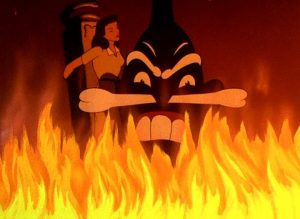 Inside the idol, we next find Lois tied to a chair, receiving third-degree questioning from the Commandant. Jumping to conclusions, he accuses Lois with disposing of the papers (never once assuming the pilot did it himself), and gives the stubborn Lois just ten minutes to renember what she did with them, “or I will be forced to brighten your memory with fire. So?” He ignites a cigarette lighter almost in Lois’s face. “So what?”. Lois replies, in her usual unrelenting, defiant fashion. (Why isn’t Lois a secret agent or spy herself, instead of just a reporter. Her lips are more tightly sealed than James Bond’s could ever be.) So, she is tied to a stake, at the center of a native sacrificial bonfire. The Commandant, in his witch doctor robe, offers her a last chance to talk, but she again defies him: “Oh, cut the comic opera stuff.” As the fire is lit, a native reports to the Commandant, and hands him something. The Commandant bellows with laughter. “I have then! Look!”, displaying the discovered documents. “Your Yankee bravery was in vain!” The information on the convoy is quickly radioed to a waiting fleet of German U-Boats.
Inside the idol, we next find Lois tied to a chair, receiving third-degree questioning from the Commandant. Jumping to conclusions, he accuses Lois with disposing of the papers (never once assuming the pilot did it himself), and gives the stubborn Lois just ten minutes to renember what she did with them, “or I will be forced to brighten your memory with fire. So?” He ignites a cigarette lighter almost in Lois’s face. “So what?”. Lois replies, in her usual unrelenting, defiant fashion. (Why isn’t Lois a secret agent or spy herself, instead of just a reporter. Her lips are more tightly sealed than James Bond’s could ever be.) So, she is tied to a stake, at the center of a native sacrificial bonfire. The Commandant, in his witch doctor robe, offers her a last chance to talk, but she again defies him: “Oh, cut the comic opera stuff.” As the fire is lit, a native reports to the Commandant, and hands him something. The Commandant bellows with laughter. “I have then! Look!”, displaying the discovered documents. “Your Yankee bravery was in vain!” The information on the convoy is quickly radioed to a waiting fleet of German U-Boats.
At an air base on the mainland, we finally see out first appearance of Clark Kent, about to hitch a ride in a two-seater fighter to catch up with Lois and the convoy. Like sitting ducks, they of course travel the same air lane as Lois’s flight, passing over the native village and the flaming bonfire. How is it that the ever-alert Nazis fail to take any pot-shots at this second plane? “Looks like they’re having a party down there”. Quips the pilot. “And us not invited. How do you like that?”, retorts Clark. But their mood quickly changes from joviality to seriousness, as they spot the wreckage of the previous plane about a mile from the village. While the pilot tries to speculate on its cause, Clark goes into action, and bails out of the plane (at least having the good sense to jump wearing a parachute, even though he’ll never need it, so as not to blow his cover).
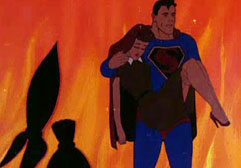 A costume change amidst the towering narive statuary, and the Man of Steel quickly frees Lois, while the superstitious natives drop their drums and flee. A machine gun emerges from the mouth of one of the idol heads, and Lois and Superman duck for cover. Superman flies out, lifting the head off of the idol. A fight ensues with several Germans inside the opened chamber, while the Commandant disappears through a stone trap door. Superman is delayed in folllowing, as the metal ring for lifting the trap door breaks off in his hands. Meanwhile, Lois finds one of the fallen Germans unconscious on the ground at the base of the idol, and borrows his white robe used in the ceremony, then merely walks in the front door, leaving Superman upstairs to figure out how to get in the hard way. When the Commandant descends to ground level inside the idol, he finds a hooded figure using the radio transmitter, but with an unauthorized call to “base 3X”. The figure’s protruding woman’s shoes give her away. “You”, shouts the Commandant. Of course, Superman finally busts in, knocks the Commandant’s lights out, and lets Lois complete her call to base. A flight of Allied bombers takes off after the U-boats, and intercepts them with depth charges. The final scene is in the office of none other than Adolf Hitler, where a radio plays near a window displaying a lightning-filled sky. An American announcer bradcasts the news of the sinking of the entire U-boat flotilla, and the convoy’s safe passage. Hitler’s in an odd mood today, displaying none of his usual verbal bluster (perhaps the weather gave him laryngitis?), and merely gives the radio’s buttons an angry flip to another station, which just happens to be playing a chorus of “Praise the Lord and Pass the Ammunition.”
A costume change amidst the towering narive statuary, and the Man of Steel quickly frees Lois, while the superstitious natives drop their drums and flee. A machine gun emerges from the mouth of one of the idol heads, and Lois and Superman duck for cover. Superman flies out, lifting the head off of the idol. A fight ensues with several Germans inside the opened chamber, while the Commandant disappears through a stone trap door. Superman is delayed in folllowing, as the metal ring for lifting the trap door breaks off in his hands. Meanwhile, Lois finds one of the fallen Germans unconscious on the ground at the base of the idol, and borrows his white robe used in the ceremony, then merely walks in the front door, leaving Superman upstairs to figure out how to get in the hard way. When the Commandant descends to ground level inside the idol, he finds a hooded figure using the radio transmitter, but with an unauthorized call to “base 3X”. The figure’s protruding woman’s shoes give her away. “You”, shouts the Commandant. Of course, Superman finally busts in, knocks the Commandant’s lights out, and lets Lois complete her call to base. A flight of Allied bombers takes off after the U-boats, and intercepts them with depth charges. The final scene is in the office of none other than Adolf Hitler, where a radio plays near a window displaying a lightning-filled sky. An American announcer bradcasts the news of the sinking of the entire U-boat flotilla, and the convoy’s safe passage. Hitler’s in an odd mood today, displaying none of his usual verbal bluster (perhaps the weather gave him laryngitis?), and merely gives the radio’s buttons an angry flip to another station, which just happens to be playing a chorus of “Praise the Lord and Pass the Ammunition.”
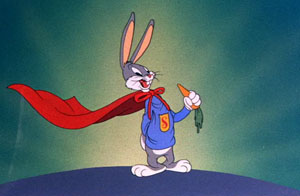 Super-Rabbit (Warner, Bugs Bunny, 4/3/43 – Charles M. (Chuck) Jones, dir.), is a confirmed super-classic, and was a favorite for infinite reruns on local stations’ kiddie cartoon shows. Among Jones’ earliest true comedy triumphs, we’ve visited this one in depth during our survey a while ago entitled “Reign of the Supertoons”. Mild-mannered experimental rabbit Bugs receives his powers through the weird science of Professot Kanifraz, with a box of super vitamized, locked-in flavorized, modern di-zionized, super carrots. After ingesting one, Bugs darts into a phone booth, emerging for the first use of a gag which writer Tedd Pierce, and later Jones’ other most well-known writer Michael Maltese, would use again and again for other characters – wearing a totally inappropriate ensemble of a pink dress, a shepherd’s crook, and with a toy lamb in tow, only to look down and react, “Whoop. Pardon me, wrong costume.” He sets himself the task of taking on Cottontail Smith, a Texas cowboy determined to rid the state of every last rabbit. The Westerner and his horse prove easy dupes for Bugs’ usual style of pranks and newly-found super-powers, aided by periodic “recharging” with a nibble from his supply of energized carrots, carried along in a cigarette case inside his ersatz Superman suit.
Super-Rabbit (Warner, Bugs Bunny, 4/3/43 – Charles M. (Chuck) Jones, dir.), is a confirmed super-classic, and was a favorite for infinite reruns on local stations’ kiddie cartoon shows. Among Jones’ earliest true comedy triumphs, we’ve visited this one in depth during our survey a while ago entitled “Reign of the Supertoons”. Mild-mannered experimental rabbit Bugs receives his powers through the weird science of Professot Kanifraz, with a box of super vitamized, locked-in flavorized, modern di-zionized, super carrots. After ingesting one, Bugs darts into a phone booth, emerging for the first use of a gag which writer Tedd Pierce, and later Jones’ other most well-known writer Michael Maltese, would use again and again for other characters – wearing a totally inappropriate ensemble of a pink dress, a shepherd’s crook, and with a toy lamb in tow, only to look down and react, “Whoop. Pardon me, wrong costume.” He sets himself the task of taking on Cottontail Smith, a Texas cowboy determined to rid the state of every last rabbit. The Westerner and his horse prove easy dupes for Bugs’ usual style of pranks and newly-found super-powers, aided by periodic “recharging” with a nibble from his supply of energized carrots, carried along in a cigarette case inside his ersatz Superman suit.
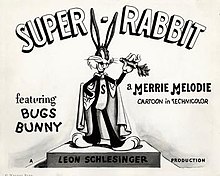 Flight power is ultimately matched by Smith and his trusty horse, who take to the skies in a two-seater fighter plane, the sights of their machine gun crosshairs zeroing in straight on Bugs. With precision timing, Bugs fools them, by ducking under the oncoming plane and grabbing hold of the fuselage, holding it fast in his grip. The plane stays with Bugs, but, like “Goofy’s Glider”, the cockpit canopy, control stick, and passengers Smith and his horse, separate from the plane and continue on under their own momentum, without wings or engine. Smith remains oblivious to their situation, and to the fact he has passed Bugs, until his horse taps him on the shoulder, and coaxes him to look down. Cowboy and horse fall out of position from under the canopy, and spin in a dizzy dive, while Bugs tosses the plane after them for a final measure to ensure their fate. But Bugs’ air speed begins to slow up and sputter along, meaning it’s “Time to recharge again.”
Flight power is ultimately matched by Smith and his trusty horse, who take to the skies in a two-seater fighter plane, the sights of their machine gun crosshairs zeroing in straight on Bugs. With precision timing, Bugs fools them, by ducking under the oncoming plane and grabbing hold of the fuselage, holding it fast in his grip. The plane stays with Bugs, but, like “Goofy’s Glider”, the cockpit canopy, control stick, and passengers Smith and his horse, separate from the plane and continue on under their own momentum, without wings or engine. Smith remains oblivious to their situation, and to the fact he has passed Bugs, until his horse taps him on the shoulder, and coaxes him to look down. Cowboy and horse fall out of position from under the canopy, and spin in a dizzy dive, while Bugs tosses the plane after them for a final measure to ensure their fate. But Bugs’ air speed begins to slow up and sputter along, meaning it’s “Time to recharge again.”
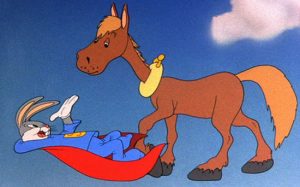 He opens the cigarette case, but fumbles his grip, causing the carrots to pour out and down below him. “Yipe”, responds Bugs in underplay. Down he falls, coming to a stop in one piece, but compressed for a moment by the impact with the ground as if he were made of rubber, them collapses. The scent of carrots reaches his nose, as he opens his eyes to find a trail of chewed carrot stubs, leading up to the feet of Smith and his horse, now dressed in their own super-suits, and looking mighty indeed. As they advance upon him, Bugs addresses the audience: “This looks like a job for a REAL Superman!” He zips into a convenient phone booth, to change out of his super-suit, into the uniform of a U.S. Marine. The villains can do nothing but stand and salute. “Sorry, fellas,” says Bugs. “I can’t play with ya anymore. I got some important work to do!” He marches off to the horizon, following a road sign pointing “To Berlin, Tokyo, and points East.”
He opens the cigarette case, but fumbles his grip, causing the carrots to pour out and down below him. “Yipe”, responds Bugs in underplay. Down he falls, coming to a stop in one piece, but compressed for a moment by the impact with the ground as if he were made of rubber, them collapses. The scent of carrots reaches his nose, as he opens his eyes to find a trail of chewed carrot stubs, leading up to the feet of Smith and his horse, now dressed in their own super-suits, and looking mighty indeed. As they advance upon him, Bugs addresses the audience: “This looks like a job for a REAL Superman!” He zips into a convenient phone booth, to change out of his super-suit, into the uniform of a U.S. Marine. The villains can do nothing but stand and salute. “Sorry, fellas,” says Bugs. “I can’t play with ya anymore. I got some important work to do!” He marches off to the horizon, following a road sign pointing “To Berlin, Tokyo, and points East.”
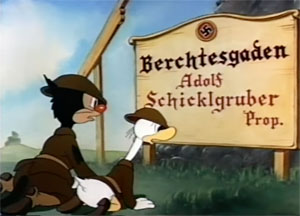 An honorable mention for The Last Round-Up (Terrytoons/Fox, Gandy Goose, 5/14/43 – Mannie Davis, dir.), It’s just a typical day for Gandy and Sergeant Sourpuss at the army camp, as Gandy assists Sourpuss in a little target practice, by playing “William Tell” and allowing the cat to shoot an apple off his head – except Sourpuss is firing shells from the barrel of an anti-aircraft cannon! The cat’s first shot hits the apple cleanly. But his second round hits Gandy right in the breadbasket, driving him through the trunks of six trees. However, the shell at least does not explode, and Gandy tells the cat it must be a dud. A closer inspection by Sourpuss proves Gandy wrong, as a blast shoots the duo sky high, driving them right through the bottom of the crescent moon. As they curve for a re-entry into the stratosphere, Gandy asks Sourpuss where they are going. A true military man to the end, Sourpuss replies, “I can’t tell ya. It’s a military secret,” Their fall is broken by a haystack, at the foot of which they encounter several random worms and insects, who each greet them with a shout of “Heil!” Sourpuss correctly guesses they have landed in Germany. It isn’t long before they have discovered a tall mountain with a palace at its pinnacle, a sign at the foot of the grounds reading that its proprietor is Adolf Shicklgruber. “Boy, what luck”, proclaims Sourpuss, and the two begin to scale their way to the summit to “get that guy”.
An honorable mention for The Last Round-Up (Terrytoons/Fox, Gandy Goose, 5/14/43 – Mannie Davis, dir.), It’s just a typical day for Gandy and Sergeant Sourpuss at the army camp, as Gandy assists Sourpuss in a little target practice, by playing “William Tell” and allowing the cat to shoot an apple off his head – except Sourpuss is firing shells from the barrel of an anti-aircraft cannon! The cat’s first shot hits the apple cleanly. But his second round hits Gandy right in the breadbasket, driving him through the trunks of six trees. However, the shell at least does not explode, and Gandy tells the cat it must be a dud. A closer inspection by Sourpuss proves Gandy wrong, as a blast shoots the duo sky high, driving them right through the bottom of the crescent moon. As they curve for a re-entry into the stratosphere, Gandy asks Sourpuss where they are going. A true military man to the end, Sourpuss replies, “I can’t tell ya. It’s a military secret,” Their fall is broken by a haystack, at the foot of which they encounter several random worms and insects, who each greet them with a shout of “Heil!” Sourpuss correctly guesses they have landed in Germany. It isn’t long before they have discovered a tall mountain with a palace at its pinnacle, a sign at the foot of the grounds reading that its proprietor is Adolf Shicklgruber. “Boy, what luck”, proclaims Sourpuss, and the two begin to scale their way to the summit to “get that guy”.
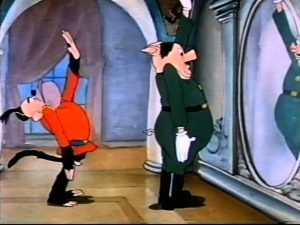 Der Fuehrer is portrayed as a moustached pig, shouting himself red in the face in mock German, to the applause of his right hand man, a dim-witted gorilla resembling Mussolini, but speaking only in monkey grunts. They spend their idle moments practicing goose-stepping, saluting “heils” to themselves in various mirrors, and in having the gorilla remove bugs from the pig’s hair (each insect’s body being in the shape of a little swastika). Most of the film is a shoot-em-up, as Gandy and Sourpuss stage a two-man seige upon the castle. A manic chase includes a wild race through the castle’s elevator system, which allows two elevator cars to run within the same shaft and pursue each other, up, down, and even sideways. The final action takes place in the castle’s cellars, where numerous barrels of German beer enjoy the aging process. Sourpuss unleashes several stacks of them upon the Nutzis, which pursue them like a steamroller, but with the sound effects of a roaring freight train. As the Axis foes become wedged between barrels, our heroes light a large container of “Blitz Powder” near a cache of ammunition within the cellar. Finding also within the depths of the castle stronghold a two-seater escape plane and a side hatchway out of the castle, Gandy and Sourpuss rev up the engine and hop in – but not before taking along one of the barrels of the German brew as a war prize. They fly out the escape doorway in the nick of time, as the powder meets the munitions arsenal, exploding the castle. The pig and gorilla are blown into the sky, but go down like true Germans, standing stiff in a heiling position. They fall into a graveyard below, their bodies lodging deep into the soil of one of the graves, with only their heiling arms extended above ground. Skeletons rise briefly out of the surrounding graves to return the “heil” salute. A final “heil” is heard from Gandy and Sourpuss in the escape plane, but their heiling hands are full of a stein apiece of good German beer from the confiscated barrel, as the film fades out.
Der Fuehrer is portrayed as a moustached pig, shouting himself red in the face in mock German, to the applause of his right hand man, a dim-witted gorilla resembling Mussolini, but speaking only in monkey grunts. They spend their idle moments practicing goose-stepping, saluting “heils” to themselves in various mirrors, and in having the gorilla remove bugs from the pig’s hair (each insect’s body being in the shape of a little swastika). Most of the film is a shoot-em-up, as Gandy and Sourpuss stage a two-man seige upon the castle. A manic chase includes a wild race through the castle’s elevator system, which allows two elevator cars to run within the same shaft and pursue each other, up, down, and even sideways. The final action takes place in the castle’s cellars, where numerous barrels of German beer enjoy the aging process. Sourpuss unleashes several stacks of them upon the Nutzis, which pursue them like a steamroller, but with the sound effects of a roaring freight train. As the Axis foes become wedged between barrels, our heroes light a large container of “Blitz Powder” near a cache of ammunition within the cellar. Finding also within the depths of the castle stronghold a two-seater escape plane and a side hatchway out of the castle, Gandy and Sourpuss rev up the engine and hop in – but not before taking along one of the barrels of the German brew as a war prize. They fly out the escape doorway in the nick of time, as the powder meets the munitions arsenal, exploding the castle. The pig and gorilla are blown into the sky, but go down like true Germans, standing stiff in a heiling position. They fall into a graveyard below, their bodies lodging deep into the soil of one of the graves, with only their heiling arms extended above ground. Skeletons rise briefly out of the surrounding graves to return the “heil” salute. A final “heil” is heard from Gandy and Sourpuss in the escape plane, but their heiling hands are full of a stein apiece of good German beer from the confiscated barrel, as the film fades out.
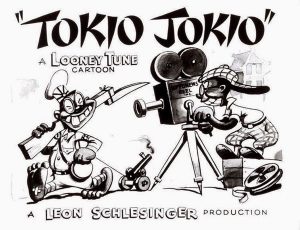 Tokio Jokio (Warner, Looney Tunes, 5/15/43 – Norman McCabe, dir.) – Gandy and Sourpuss having cleaned up the European front, it’s time for Warners to take on the Nippon, all in some of the highest bad taste. The film is introduced with ten seconds of film scratches and lines like a worn-out theatrical print, as Mel Blanc announces it as a reel captured from the enemy, representing a “typical example of vicious Japo-Natzi propaganda.” It is a parody of the American newsreel, allegedly the way the enemy would present one. Several sequences of the various stereotypical spot gags feature planes or air-attack related gags. First, Japan’s best air raid siren is demonstrated. It is a series of megaphones, behind which two polite Japanese take turns sticking each other in the rear end with a large pin, screaming into the megaphones at the top of their lungs during each pin-poke. A “listening post” is merely a wooden post driven into the ground, with dozens of keyholes drilled into it, at which a nosy Japanese soldier listens intently. An “aircraft spotter”, normally a term referring to a lookout who can identify the make of incoming planes in the sky, is depicted as another Japanese soldier, painting large round spots on the side of a plane. (A Zero already had large red ones on its wings and sides, so this would be a little overkill.) A lesson to civilians states not to approach fallen incendiary bombs for the first five seconds. A Japanese gentleman with glasses, top hat and pointed umbrella waits out the allotted time, then approaches a fallen and glowing bomb, holding out a wiener on the end of his umbrella for roasting. The bomb explodes, leaving a deep crater. “Losing face, please” states the gentleman’s voice from the crater. He rises out – with only his glasses and hat remaining where his head had once been. A plane is launched from a carrier deck by means of a “super-duper catapult device” – a large slingshot and rubber band planted in the center of the deck. Coming in from the other direction is a Zero fighter, equipped with new tricycle landing gear – a belly-hatch opens, to extend a kid on a real tricycle fasted to a connector pole, pedaling like crazy. Finally, we view Japan’s busiest aircraft carrier – a garbage scow, full to the railings with smashed and wrecked aircraft.
Tokio Jokio (Warner, Looney Tunes, 5/15/43 – Norman McCabe, dir.) – Gandy and Sourpuss having cleaned up the European front, it’s time for Warners to take on the Nippon, all in some of the highest bad taste. The film is introduced with ten seconds of film scratches and lines like a worn-out theatrical print, as Mel Blanc announces it as a reel captured from the enemy, representing a “typical example of vicious Japo-Natzi propaganda.” It is a parody of the American newsreel, allegedly the way the enemy would present one. Several sequences of the various stereotypical spot gags feature planes or air-attack related gags. First, Japan’s best air raid siren is demonstrated. It is a series of megaphones, behind which two polite Japanese take turns sticking each other in the rear end with a large pin, screaming into the megaphones at the top of their lungs during each pin-poke. A “listening post” is merely a wooden post driven into the ground, with dozens of keyholes drilled into it, at which a nosy Japanese soldier listens intently. An “aircraft spotter”, normally a term referring to a lookout who can identify the make of incoming planes in the sky, is depicted as another Japanese soldier, painting large round spots on the side of a plane. (A Zero already had large red ones on its wings and sides, so this would be a little overkill.) A lesson to civilians states not to approach fallen incendiary bombs for the first five seconds. A Japanese gentleman with glasses, top hat and pointed umbrella waits out the allotted time, then approaches a fallen and glowing bomb, holding out a wiener on the end of his umbrella for roasting. The bomb explodes, leaving a deep crater. “Losing face, please” states the gentleman’s voice from the crater. He rises out – with only his glasses and hat remaining where his head had once been. A plane is launched from a carrier deck by means of a “super-duper catapult device” – a large slingshot and rubber band planted in the center of the deck. Coming in from the other direction is a Zero fighter, equipped with new tricycle landing gear – a belly-hatch opens, to extend a kid on a real tricycle fasted to a connector pole, pedaling like crazy. Finally, we view Japan’s busiest aircraft carrier – a garbage scow, full to the railings with smashed and wrecked aircraft.
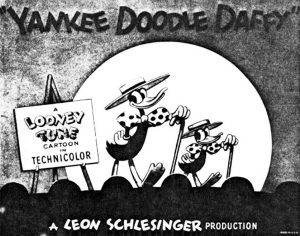 Yankee Doodle Daffy (Warner, Porky and Daffy, 6/5/43 – I. (Friz) Freleng dir.) – Porky Pig, president of Smeller Productions, is slipping out to catch a plane for a vacation, loaded down with suitcases and golf clubs, when he is ambushed by Daffy Duck, Actor’s Agent, who claims to represent “the greatest discovery since the sweater girl” – a lollipop-sucking runt of a duck named “Sleepy” Lagoon (reference to a current Harry James song hit). Rather than put the kid on to perform himself, Daffy personally demonstrates all the things he can allegedly do by giving his own performance of Sleepy’s entire act, while Porky desperately attempts to make his flight. As Daffy rides Porky bareback while singing a cowboy number, Porky bucks him off like a bronco into an open safe, then shuts the door on Daffy, whirling the combination lock dials to seal the duck in. Leaving behind his golf clubs, Porky still has time to grab his suitcases, and makes the flight after all. However, just as he is settling with ease into his seat, another round of singing is heard from the cockpit. At the controls sits Daffy, performing with exuberance
Yankee Doodle Daffy (Warner, Porky and Daffy, 6/5/43 – I. (Friz) Freleng dir.) – Porky Pig, president of Smeller Productions, is slipping out to catch a plane for a vacation, loaded down with suitcases and golf clubs, when he is ambushed by Daffy Duck, Actor’s Agent, who claims to represent “the greatest discovery since the sweater girl” – a lollipop-sucking runt of a duck named “Sleepy” Lagoon (reference to a current Harry James song hit). Rather than put the kid on to perform himself, Daffy personally demonstrates all the things he can allegedly do by giving his own performance of Sleepy’s entire act, while Porky desperately attempts to make his flight. As Daffy rides Porky bareback while singing a cowboy number, Porky bucks him off like a bronco into an open safe, then shuts the door on Daffy, whirling the combination lock dials to seal the duck in. Leaving behind his golf clubs, Porky still has time to grab his suitcases, and makes the flight after all. However, just as he is settling with ease into his seat, another round of singing is heard from the cockpit. At the controls sits Daffy, performing with exuberance
“We Watch the Skyways”, a Max Steiner/Gus Kahn composition from the Technicolor flag-waver, “Dive Bomber” with Errol Flynn and Fred MacMurray. The song would also receive reuse in the score of John Wayne’s “Operation Pacific”. Porky’s had enough, grabs what he believes is a parachute, and jumps from the plane. He pulls the ripcord, only to discover he is strapped to – Daffy, who somehow floats them slowly down through the skies like a real chute (I guess it’s all those downy-soft feathers that do it), while half-singing, half humming a chorus of “Angel in Disguise”, introduced by Anne Sheridan in “It All Came True”, The two land safely atop the roof of Porky’s office building, Daffy pursues Porky down the fire escapes, and back into the office, where he single-handedly performs Sleepy’s grand finale in a blur of double-exposed images. “Stop it. STOP IT!”, shouts Porky, finally relenting to see what the kid can do. Sleepy at last speaks for himself, singing in a surprising booming baritone voice, but with one weakness. As he hits the high notes of his song, he pauses to cough and clutch his chest, while finishing the song’s title line “In the Garden of – – – My Heart.”
 The Yankee Doodle Mouse (MGM, Tom and Jerry, 6/26/43 – William Hanna/Joseph Barbera, dir.) – Most war-related films of the day were so chock-full of current topical references or specific depictions of an enemy nation that they stood little chance of ever being shown again after the war ended without explanation of the humor, or at least placement of their subject matter into the appropriate specific time period. Hanna and Barbera’s masterpiece was largely an exception to this rule. Though they had produced other films where the habits of rival animators were followed (such as “The Lonesome Mouse”, where Jerry defaces an image of Tom to resemble Adolf Hitler), the concept for this particular episode was quite original and brilliant – stage an entire war, in several major campaigns and with nods to every branch of the services, all within the confines of the basement of Tom and Jerry’s house – and with neither one of them representing any particular enemy nation. The result (with the exception of one gag removed from the reissue print and lost to a vault fire, dealing with using Tom’s tongue to lick the adhesive on a book of ration stamps) was amazingly timeless, and has withstood the test of constant re-airings on television over the years without a word of explanation, or need to identify its activities with any particular war. It is this quality that I suspect was responsible for the film being singled out to receive a deserved Academy Award, the duo’s first after two nominations in previous seasons.
The Yankee Doodle Mouse (MGM, Tom and Jerry, 6/26/43 – William Hanna/Joseph Barbera, dir.) – Most war-related films of the day were so chock-full of current topical references or specific depictions of an enemy nation that they stood little chance of ever being shown again after the war ended without explanation of the humor, or at least placement of their subject matter into the appropriate specific time period. Hanna and Barbera’s masterpiece was largely an exception to this rule. Though they had produced other films where the habits of rival animators were followed (such as “The Lonesome Mouse”, where Jerry defaces an image of Tom to resemble Adolf Hitler), the concept for this particular episode was quite original and brilliant – stage an entire war, in several major campaigns and with nods to every branch of the services, all within the confines of the basement of Tom and Jerry’s house – and with neither one of them representing any particular enemy nation. The result (with the exception of one gag removed from the reissue print and lost to a vault fire, dealing with using Tom’s tongue to lick the adhesive on a book of ration stamps) was amazingly timeless, and has withstood the test of constant re-airings on television over the years without a word of explanation, or need to identify its activities with any particular war. It is this quality that I suspect was responsible for the film being singled out to receive a deserved Academy Award, the duo’s first after two nominations in previous seasons.
 As is typical for our heroes, the chase is on, and Jerry is headed straight for a mousehole labeled, “Cat Raid Shelter”. The mousehole is surrounded with sandbags like a battlefield bunker, and is chock-full on booby traps, like a spring-loaded mousetrap used to launch a tomato into Tom’s face when he peers in. An egg crate (marked as “Hen-Grenades”), provides more defensive ammunition, as do the corks from champagne bottles in a wine rack, and a brick launched on a bended spatula to sink a small pot Tom is floating on in a water barrel. On the writing stationary of “Mouse Headquarters, Cheese Division”, “Lieutenant” Jerry sends a first war communique to an unknown superior, reading, “Sighted cat – Sank same.”
As is typical for our heroes, the chase is on, and Jerry is headed straight for a mousehole labeled, “Cat Raid Shelter”. The mousehole is surrounded with sandbags like a battlefield bunker, and is chock-full on booby traps, like a spring-loaded mousetrap used to launch a tomato into Tom’s face when he peers in. An egg crate (marked as “Hen-Grenades”), provides more defensive ammunition, as do the corks from champagne bottles in a wine rack, and a brick launched on a bended spatula to sink a small pot Tom is floating on in a water barrel. On the writing stationary of “Mouse Headquarters, Cheese Division”, “Lieutenant” Jerry sends a first war communique to an unknown superior, reading, “Sighted cat – Sank same.”
Tom launches a counter-attack, folding and creating a paper airplane, then loading into its folds a small, lit firecracker. He makes a perfect toss, flinging the makeshift aircraft directly in front of Jerry’s hole. But Jerry meets this threat with a mighty blow – of air from his lungs, underneath the wings, that drives the plane back in a wide loop around the room, gliding in from behind Tom directly between his legs, and depositing the firecracker directly under Tom’s chin. A loud KER-BOOM leaves Tom’s face charred, disreputable, and disgruntled.
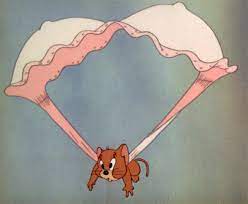 Jerry counters by creeping up behind Tom with what looks like a king-size firecracker, almost as large as Tom himself, then lights the fuse and runs for it. Tom smells the burning fuse, turns, and cringes in fright. The fuse burns to its end, but the firecracker pulls a series of surprises. It is built like a set of nested Russian dolls, splitting open in haves, spirals, etc. to reveal smaller and smaller firecrackers hidden inside. Its last is barely a quarter-inch tall. Tom picks up the midget device with a hearty chuckle (a sound borrowed from a Barney Bear soundtrack), but finds the little incendiary packs a mighty wallop, blasting him just as forcefully as we expected from the original big one. Anticipating an offensive from Tom, Jerry leaps into a hole in a barrel tipped on its side. Inside, he has rigged to an old innertube a small box, painted with red, white and blue stripes on its rear, and in the front the red toothy-mouth design that was associated during WWII with the famous squadron known as the “Flying Tigers”. Small wings are fastened on both sides of the box, and inside the box is a goodly cargo of light bulbs. The innertube is fastened inside the barrel from one end as a launcher, its other end held behind the “plane” by a piece of rope. Jerry releases the rope, and the plane quickly takes off out the open top side of the barrel. Opening the rear flap of the box to serve as a bomb bay, Jerry begins dropping bulb after bulb around the poor cat below, who leaps at every loud “pop” as each glass bulb shatters. Jerry releases an additional weapon from the “plane” – a banana, to add insult to injury by smashing into a mush on Tom’s nose. This is all a self-respecting cat can stand. Tom searches the basement for some new firepower, and finds it, in the form of a hose full of Roman Candles left over from the Fourth of July. Igniting the hose’s contents, Tom begins blasting away with multicolor flaming balls that chew gaping holes into Jerry’s flying box. Jerry has no choice but to bail out, coming prepared with a “two cup” parachute, constructed out of a ladies’ brassiere. An extended battle with the Roman Candles ensues, each of the characters taking their licks as the runaway sparks shoot all around the room. Finally, Tom draws a bead on Jerry with a toy dart gun, just before Jerry can regain the safety of his mousehole, and catches Jerry by a rubber suction-cup dart on the tail. Tom has saved his biggest weapon for last – a king-size July 4th skyrocket. Lighting the long fuse, he attempts to tie Jerry to the device’s wooden rudder stick. Jerry assists by holding the string with one finger so that Tom can tie a firm knot – then easily climbs out from the ropes, leaving Tom’s hands securely tied to the stick. The helpless cat can do nothing but attempt to blow out the fuse with his breath, but the effort is too late. Cat and rocket shoot into the skies, resulting in a huge explosion, lighting up the sky with sparks in the pattern og an American flag. A proud Jerry watches the display, standing at stiff salute. The last scene depicts Jerry’s final was communique, with request to his superior to “Send more cats!”
Jerry counters by creeping up behind Tom with what looks like a king-size firecracker, almost as large as Tom himself, then lights the fuse and runs for it. Tom smells the burning fuse, turns, and cringes in fright. The fuse burns to its end, but the firecracker pulls a series of surprises. It is built like a set of nested Russian dolls, splitting open in haves, spirals, etc. to reveal smaller and smaller firecrackers hidden inside. Its last is barely a quarter-inch tall. Tom picks up the midget device with a hearty chuckle (a sound borrowed from a Barney Bear soundtrack), but finds the little incendiary packs a mighty wallop, blasting him just as forcefully as we expected from the original big one. Anticipating an offensive from Tom, Jerry leaps into a hole in a barrel tipped on its side. Inside, he has rigged to an old innertube a small box, painted with red, white and blue stripes on its rear, and in the front the red toothy-mouth design that was associated during WWII with the famous squadron known as the “Flying Tigers”. Small wings are fastened on both sides of the box, and inside the box is a goodly cargo of light bulbs. The innertube is fastened inside the barrel from one end as a launcher, its other end held behind the “plane” by a piece of rope. Jerry releases the rope, and the plane quickly takes off out the open top side of the barrel. Opening the rear flap of the box to serve as a bomb bay, Jerry begins dropping bulb after bulb around the poor cat below, who leaps at every loud “pop” as each glass bulb shatters. Jerry releases an additional weapon from the “plane” – a banana, to add insult to injury by smashing into a mush on Tom’s nose. This is all a self-respecting cat can stand. Tom searches the basement for some new firepower, and finds it, in the form of a hose full of Roman Candles left over from the Fourth of July. Igniting the hose’s contents, Tom begins blasting away with multicolor flaming balls that chew gaping holes into Jerry’s flying box. Jerry has no choice but to bail out, coming prepared with a “two cup” parachute, constructed out of a ladies’ brassiere. An extended battle with the Roman Candles ensues, each of the characters taking their licks as the runaway sparks shoot all around the room. Finally, Tom draws a bead on Jerry with a toy dart gun, just before Jerry can regain the safety of his mousehole, and catches Jerry by a rubber suction-cup dart on the tail. Tom has saved his biggest weapon for last – a king-size July 4th skyrocket. Lighting the long fuse, he attempts to tie Jerry to the device’s wooden rudder stick. Jerry assists by holding the string with one finger so that Tom can tie a firm knot – then easily climbs out from the ropes, leaving Tom’s hands securely tied to the stick. The helpless cat can do nothing but attempt to blow out the fuse with his breath, but the effort is too late. Cat and rocket shoot into the skies, resulting in a huge explosion, lighting up the sky with sparks in the pattern og an American flag. A proud Jerry watches the display, standing at stiff salute. The last scene depicts Jerry’s final was communique, with request to his superior to “Send more cats!”
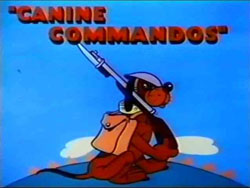 Canine Commandos (Lantz/Universal, Andy Panda, 6/28/43 – Alex Lovy, dir.) Another of the most rarely-seen Lantz cartoons, this one feels like a quota-filler, using a generic spot gag reel on the training of army dogs as an excuse to meet production schedule on Andy Panda stories, by merely dropping Andy into a handful of shots as the alleged dog trainer. He only gets one line of dialogue, and his regular voice doesn’t even show up for the date – Andy speaking for the first and only time as a baritone. It’s much like a late Bob Clampett Porky Pig Looney Tune, when Porky would just appear as a figurehead at times the writers couldn’t think of anything new for him to do. But then, the Lantz writers weren’t the only ones in a rut. At Terrytoons, Gandy and Sourpuss were frequently meeting the same fate, as illustrated last week with their cameo in “Scrap for Victory”, and in other episodes such as “Barnyard Blackout”, and coincidentally, the unseen “Patriotic Pooches” from the same year as this production.
Canine Commandos (Lantz/Universal, Andy Panda, 6/28/43 – Alex Lovy, dir.) Another of the most rarely-seen Lantz cartoons, this one feels like a quota-filler, using a generic spot gag reel on the training of army dogs as an excuse to meet production schedule on Andy Panda stories, by merely dropping Andy into a handful of shots as the alleged dog trainer. He only gets one line of dialogue, and his regular voice doesn’t even show up for the date – Andy speaking for the first and only time as a baritone. It’s much like a late Bob Clampett Porky Pig Looney Tune, when Porky would just appear as a figurehead at times the writers couldn’t think of anything new for him to do. But then, the Lantz writers weren’t the only ones in a rut. At Terrytoons, Gandy and Sourpuss were frequently meeting the same fate, as illustrated last week with their cameo in “Scrap for Victory”, and in other episodes such as “Barnyard Blackout”, and coincidentally, the unseen “Patriotic Pooches” from the same year as this production.
The latest innovation in canine warfare is the “para-pups” – dogs taught to leap with parachutes from high-flying planes. Their “complete equipment” quickly follows, as each of them is tossed a bone apiece, also tied to their own respective chutes. A mile-long dachshund appears, however, to be in free fall, nose straight down. His fleas emerge from his fur, survey the desperate situation, and jump ship from the dog with their own miniature parachutes. At the last minute, the dachshund is saved, as four small parachutes open from nowhere in a row down the length of his body, with a smaller fifth one opening to support the weight of his tail.
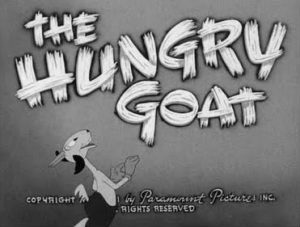 The Hungry Goat (Paramount/Famous, Popeye, 6/26/43 – Dan Gordon, dir.), receives honorable mention for a few brief scenes in the final chase, as a goat (Billy the Kid) fast talks his way into a friendship with the Admiral of the battleship to which Popeye is assigned, while getting the sailor-man in Dutch with his superior officer, all for the purpose of obtaining a square meal – of the battleship itself. The Admiral departs for an afternoon’s shore leave at the movies, where the same cartoon projects in real time as events develop aboard ship. Popeye attempts to defend the ship from devouring, while the goat manipulates the imagery seen by the Admiral in the theater to keep his culinary intentions hidden from the old salt as long as possible. During the chasing round, Popeye falls from above the decks onto the prop of a small plane carried on board. The engine makes contact, and the plane takes off, carrying Popeye aloft when his uniform gets caught around the nose of a torpedo payload hanging from the plane’s underbelly. At one point, Popeye’s uniform begins to unravel, and the sailor is literally left hanging by a thread just above the water, becoming shirtless, then yanked upwards by the final inch of thread at the last minute. As Popeye disappears upwards from the film frame, Billy is finally revealed to the Admiral, chewing upon the barrels of the battleship’s mighty guns. The Admiral makes a hasty departure from the theater, returning to the ship, and orders Popeye to come down from the plane, which the sailor does by jumping out and landing feet first upon the deck. “Where is that goat?” demands the Admiral. Riotous laughter s heard from offscreen, as the camera once again pulls back for a view inside the theater. Billy has taken it on the “lamb”, and is now seated in the Admiral’s seat in the theater himself, laughing himself silly at the two sailors being left without a recourse and with a badly-chewed boat, as the screen image behind him fades Popeye and the admiral from view, replacing them with the Paramount mountain for the closing credit.
The Hungry Goat (Paramount/Famous, Popeye, 6/26/43 – Dan Gordon, dir.), receives honorable mention for a few brief scenes in the final chase, as a goat (Billy the Kid) fast talks his way into a friendship with the Admiral of the battleship to which Popeye is assigned, while getting the sailor-man in Dutch with his superior officer, all for the purpose of obtaining a square meal – of the battleship itself. The Admiral departs for an afternoon’s shore leave at the movies, where the same cartoon projects in real time as events develop aboard ship. Popeye attempts to defend the ship from devouring, while the goat manipulates the imagery seen by the Admiral in the theater to keep his culinary intentions hidden from the old salt as long as possible. During the chasing round, Popeye falls from above the decks onto the prop of a small plane carried on board. The engine makes contact, and the plane takes off, carrying Popeye aloft when his uniform gets caught around the nose of a torpedo payload hanging from the plane’s underbelly. At one point, Popeye’s uniform begins to unravel, and the sailor is literally left hanging by a thread just above the water, becoming shirtless, then yanked upwards by the final inch of thread at the last minute. As Popeye disappears upwards from the film frame, Billy is finally revealed to the Admiral, chewing upon the barrels of the battleship’s mighty guns. The Admiral makes a hasty departure from the theater, returning to the ship, and orders Popeye to come down from the plane, which the sailor does by jumping out and landing feet first upon the deck. “Where is that goat?” demands the Admiral. Riotous laughter s heard from offscreen, as the camera once again pulls back for a view inside the theater. Billy has taken it on the “lamb”, and is now seated in the Admiral’s seat in the theater himself, laughing himself silly at the two sailors being left without a recourse and with a badly-chewed boat, as the screen image behind him fades Popeye and the admiral from view, replacing them with the Paramount mountain for the closing credit.


 Charles Gardner is an animation enthusiast who toils by day as a member of LA Law – but by nights and weekends indulges in classic jazz and ragtime as a performer; and studies classic Hollywood cartoons… maybe a little too much.
Charles Gardner is an animation enthusiast who toils by day as a member of LA Law – but by nights and weekends indulges in classic jazz and ragtime as a performer; and studies classic Hollywood cartoons… maybe a little too much.


































































































































































The Japanese legend of Momotarou concerns a boy hero who, with three talking animal companions (a dog, a monkey and a pheasant), voyages to a distant island overrun by demons. In “Momotarou no umiwashi”, or “Momotarou’s Sea Eagles” (Geijutsu Eigasha [Art Film Production], 25/3/43 — Mitsuyo Seo, dir.), that island is identified as Oahu, and the demons are fat, drunken, cowardly American servicemen. This animated war propaganda featurette dramatises the bombing of Pearl Harbor from the perspective of the Japanese military, packaged as entertainment for young children.
The film begins on an aircraft carrier in rough seas, as the cute bunnies of the Japanese navy prepare the planes for combat and send semaphore signals with their ears. Commander Momotarou gives the assembled dogs, monkeys and pheasants of the air corps their orders to attack the demon island, shown on a wall chart as a fairly accurate map of Oahu. The animals take some time getting ready — one dog has trouble putting on his Rising Sun headband — but eventually they all board their fighter planes and take off for Hawaii, pausing en route only to reunite a lost baby bird with its mother. Once there, they waste no time bombing the naval base to smithereens.
The most prominent American in the cartoon is none other than Bluto, a fat, bearded sailor who does not articulate words, but constantly groans, mumbles and blubbers in a basso profundo worthy of Gus Wicke. At one point he reaches into his shirt to pull out, not a can of spinach, but a bottle, and proceeds to chug away. When all is lost, blubbering Bluto shakes all the colours off the Stars and Stripes, turning it into a white flag of surrender. But the cute animals show him no mercy.
There are some lighthearted moments among the carnage, as when a planeload of airborne monkeys form a human ladder — or rather, a simian one — all the way to the ground to destroy a cargo plane in an act of sabotage (Famous Studios would have called it “japotage”). In the end, Pearl Harbor is reduced to a morass of smoldering hulks and floating bottles as “The Star-Spangled Banner” plays mournfully in the background. The animals return to the aircraft carrier in triumph, as the one plane that was damaged by American anti-aircraft fire is rescued by the mother bird whom they helped earlier in the cartoon.
At 37 minutes, “Momotarou no umiwashi” is quite slow-paced, and subsequent history has deprived it of whatever entertainment value it might have had. Director Mitsuyo Seo, whose personal politics leaned strongly to the left, only made propaganda films under duress after being imprisoned and tortured, and he was troubled by the effect they had on his country’s young people. While “Momotarou no umiwashi” inspired Osamu Tezuka to become a cartoonist, it inspired many other boys to go off to their deaths. After the war Seo directed a pro-democracy film that failed to find a distributor; he then abandoned animation altogether and became an illustrator of children’s books. He died in 2010 at the age of 98. Seo’s assistant on this film, Tadahito Mochinaga, later directed numerous stop-motion animated features and television specials for Rankin/Bass.
“Momotarou no umiwashi” may be a cartoon that will live in infamy, but it and its sequel (“Momotaro: Umi no shinpei”, or “Momotarou: Sacred Sailors”, Japan’s first feature-length animated film) are important landmarks in the history of anime.
The “SUPER RABBIT”(Leon Schlesinger/WB/Vitaphone, 1943), Prof.Canafras, is a Richared Haydn type, for some reason, not voiced by hm, but Dick Nelson does a hilarious job..eggstac–tly..love that funny horse scene,topop.
Paul, I believe Steve Stanchfield alluded to this Japanese animated film to me several years ago. Is it available anywhere?
Coop, I thought that WAS Richard Haydn who did the voice of the professor. I guess Haydn had a radio character from the mid-’30s into the ’40s called “Professor Karp”? I only know it from the DICK VAN DYKE episode with old-time radio stars, and have yet to hear a recording of the series – if any exist. Did Haydn voice ANY animated cartoon characters? I know that on THE ALVIN SHOW, Shep Menken (?) did a Richard Haydn-like mad scientist called Prof. Clyde Crashcup.”
The real Mr. Haydn voiced the Caterpillar in Disney’s “Alice in Wonderland.”
Momotarou no umiwashi” is on YouTube. For some reason I can’t put links in these comments, just as I can’t use italics or diacritical marks. The print I saw lacks subtitles, but there’s very little dialogue in the film anyway. I don’t know if it’s available on home video.
I suppose if I had a name like “Cottontail Smith”, I’d hate rabbits too. Not to mention Easter.
Schwein-Hitler’s fractured German double-talk in “The Last Round Up” is a scream! “Blut verstendebar Hunden jodelbar Wasser! Die Besetzung recht das Sage mit der Kloeserause!” Whoever did that voice must have spent a lot of time listening to Hitler on the radio and then improvised his lines on the spot. You couldn’t write stuff like that down in a script. Nein, umgebloden Hasenpfeffer Kartoffel!
While I always enjoy “The Hungry Goat”, seeing “Yankee Doodle Daffy” again was a real treat for me. That cartoon was such a ubiquitous fixture of cheap public domain collections in the early days of home video that I soon tired of it and got in the habit of fast-forwarding through it whenever it came on. I don’t think I’ve seen it from beginning to end in 25 years, maybe longer. There’s an awful lot of funny stuff in it, and Mel Blanc’s performance is a real tour de force. I think the problem is that, after Daffy’s long and hysterical buildup, anything that Sleepy actually does in the end is going to come across as an anti-climax. It might have been funnier if the full scope of Sleepy’s talents had been left entirely to the viewer’s imagination. So I’ve come up with an alternative ending:
“…Let’s see what the kid can do!” Sleepy puts his lollipop back in its case, walks slowly to Daffy, hands him a letter, and then exits in an uncharacteristic burst of speed. Daffy opens the letter and reads it. “Dear Sap: While you were out, I signed on with the ZIPPO MARX agency. Happy landings, loser! Sleepy Lagoon” Daffy tears up the letter and says: “Shucks! I lose more clients to Zippo that way!”
Fantastic array of wartime cartoons, most of which are widely available if anyone wants to own themselves copies before they entirely disappear. The TOM AND JERRY cartoon is fantastic, perhaps one of those titles you’d play in case someone has never seen a classic theatrical title in this series and wants to know waht all the fuss is about, after which you should show them also “KITTY FOILED”, “DR. JEKYL AND MR. MOUSE and, just so they know where all the fun started, “PUSS GETS THE BOOT”, acknowledging “THE NIGHT BEFORE CHRISTMAS” just to show that the cat and mouse also had a cease-fire for the Holiday Season. Thanks for the description of the Max Fleischer SUPERMAN cartoon…or is this one of the Famous Studios’ take on the comics character? I know I’d seen this cartoon, but it helps to become reacquainted with the visuals through description, which is why I read these posts. Good job as always.
“The Hungry Goat” is only one unsuccessful attempt on the part of the newly hatched Famous Studios to enter the screwball animal cartoon era. Its deviation from the Popeye formula is noted by the boy in the movie-audience-within-the-movie who queries, “Why don’t Popeye eat his spinach and sock him one?” Of course Popeye doing so would really depart from the script–Popeye is kind to “aminals,” you know. But then, maybe if Max Fleischer had sunk Gulliver and exterminated Hoppity and done a Popeye feature and then a Superman feature, there might not have been a Famous Studios.
“Tokio Jokio” is truly hateful, with no humor to compensate.